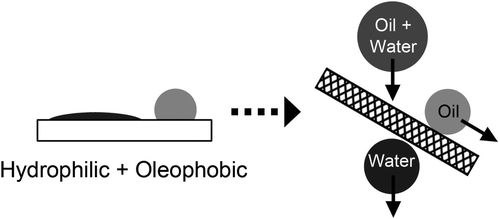New smart coating could make oil-spill cleanup faster and more efficient

In the wake of recent off-shore oil spills, and with the growing popularity of "fracking"—in which water is used to release oil and gas from shale—there's a need for easy, quick ways to separate oil and water. Now, scientists have developed coatings that can do just that. Their report on the materials, which also could stop surfaces from getting foggy and dirty, appears in ACS Applied Materials & Interfaces.
J.P.S. Badyal and colleagues point out that oil-spill cleanup crews often use absorbents, like clays, straw and wool to sop up oil, but these materials aren't very efficient because they also sop up a lot of water. Extra steps and equipment also are needed to remove the oil from the absorbent, which is difficult to do on a ship. Recently, researchers have turned their attention to new smart materials called "oleophobic-hydrophilic" coatings that instead let the water through and repel the oil. However, the films that have been reported so far take several minutes to do the separation, are complicated to make or aren't very good at repelling oil. So, Badyal's team set out to improve these materials.
They developed oleophobic-hydrophilic coatings that they applied to pieces of metal mesh, just like what's used in screen doors. When they poured an oil-water mixture onto it, the water dripped through into the container below, while the oil remained perched atop the mesh surface. Then, they simply tilted the mesh so the oil went into another container. The separation was instantaneous and more efficient than existing films, and it only took one step to make the coating. The team also demonstrated that it could serve as an anti-fogging and self-cleaning film.
More information: "Ultrafast Oleophobic-Hydrophilic Switching Surfaces for Antifogging, Self-Cleaning, and Oil-Water Separation" ACS Appl. Mater. Interfaces, Article ASAP. DOI: 10.1021/am500882y
Abstract
Smooth copolymer–fluorosurfactant complex film surfaces are found to exhibit fast oleophobic–hydrophilic switching behavior. Equilibration of the high oil contact angle (hexadecane = 80°) and low water contact angle (<10°) values occurs within 10 s of droplet impact. These optically transparent surfaces display excellent antifogging and self-cleaning properties. The magnitude of oleophobic–hydrophilic switching can be further enhanced by the incorporation of surface roughness to an extent that it reaches a sufficiently high level (water contact angle <10° and hexadecane contact angle >110°), which, when combined with the inherent ultrafast switching speed, yields oil–water mixture separation efficiencies exceeding 98%.
Journal information: ACS Applied Materials and Interfaces
Provided by American Chemical Society

















